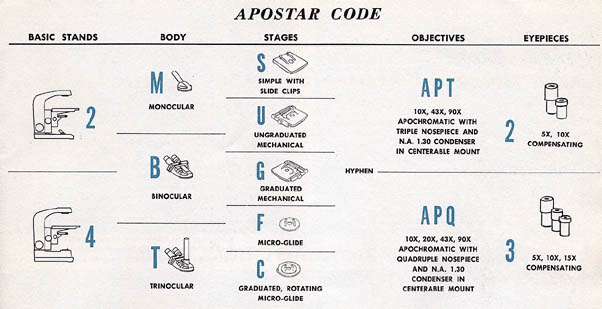

All the catalogs for the various scopes lay out a scheme much as above using a significant number scheme to designate a scope's configuration. For instance: for an APOSTAR scope having a Series 2 stand, a binocular head, a microglide stage, a quadruple nosepiece, and furnished with 5x and 10x compensating eyepieces, the configuration would have been '2BFAPQ2'.
AO/Spencer Microscope 'Odds and Ends'

As you can see above, there were three heads that accepted vertical eyepiece (photo) tubes. I assume the tubes are really the same tube -- I know that the Cat #96 tube and the Cat# 1099 tube are the same at least. Eldred Spell's practiced eye measured as follows:
Working length (the critical bit) shoulder-to-shoulder = 4.138" or 105.11mm
Thread length (not critical) = 0.160 inches, or 4.06mm
Outer thread diameter = 0.9055" or 22.999mm (call it 23.0)
Inner thread diameter in the trinoc head measures 0.876" or 22.25mm
Thread pitch is 36 per inch, which is interchangeable with 0.7mm. There are only four or five threads, so a precise match isn't necessary. The shoulder determines alignment, not the threads.
ID at threaded end is 0.777" or 19.74mm. This is not critical, but may be useful to know.
ID at open end is 23.2mm on average. I find this annoying, because there is enough play to let my camera tilt considerably off-axis. There is a real danger of getting an eyepiece stuck, but I would experiment with a slightly smaller opening.
OD of tube is 0.985" or 25.02mm. This is not critical and I would recommend a thicker tube simply for mechanical strength.
The Cat# 1044 vertical tube has dimensions as kindly supplied by Mark Simmons here.
Eldred Spell writes of the Cat# 1044:
"I've realized that the measurements for the Series 10 and later (above in image) could lead someone astray. The tube marked as 1.025" is critical for diameter, but not for length -- although if it is any longer it may hang on the prism. The tube on my Expostar measures 1.082". Keeping it to 1.0" is probably advisable.
The critical measurement is shoulder to shoulder, which should be 4.861", assuming I can still do subtraction. The overall length of 5.886 isn't important -- in itself."
Eldred Spell provides the critical information on the AO Cat# 1056T here.
AO objective mounting threads and eyepiece sizes (23mm outer diameter) follow the RMS standards -- see a good overview here.
Pre-1985 AO Objectives are 34mm parfocal and thus are neither DIN (45mm parfocal) nor JIS (36mm parfocal) -- see my 'Objectives' page for more information on this.
AO-Reichert Objectives from 1985 and on (Series 310, 410, etc.) are DIN (45mm parfocal)
The tubelengths for AO Scopes were 160mm prior to the Series 10 era, infinity corrected afterwards, except for Metallurgical scopes which were always infinity corrected. See my attempt at a short history lesson for more information.
The substage filter ring for Series 10 scopes accept 33mm diameter filters (as opposed to the 110 series, which accept 34.5mm*). But prior to this must have been 32mm because Needham ('The Practical Use of the Microscope, 1958, p. 281) furnishes a useful table as follows:
| Maker | Stop Carrier Diameters (mm) |
| C. Baker of Holborn, R&J Beck, James Swift & Son, and W. Watson & Sons | 35 |
| B&L (Bausch & Lomb) | 33.5 |
| American Optical Company | 32.0 |
| C. Reichert | 31.0 |
| E. Leitz | 29.0 |
| Swift and Watson & Sons | 22.2 |
Needham laments:
"It is unfortunate that at least seven different sizes of stop carriers are made. As the back lens of the largest substage condenser is 29 mm. diameter, 33 mm. could be adopted as a standard diameter stop carrier for the large back lens substage condensers and 22.2 mm. for the small back lens condenser."
Maybe AO took his advice and moved in that direction?
* Grant Farnsworth shares: "You mention that series 10 and later scopes accept 33 mm filters, though older scopes may have used 32. I just thought I would mention that according to the 110 user manual, the filter size on it (and later scopes, presumably) is 34.5 mm. I have both a 10 and 110 and have verified that a 34.5 mm filter works both in the condenser filter slot and in the spot on top of the light. I have also verified (as you have) that the 10 series takes a smaller filter. I don't have any 33 mm filters, but the 32 mm filters I have fit and are just a hair too small to fit quite right, so I think it must be 33."
AO made a reflecting objective which shows up on eBay from time to time. I've never had one but Needham has a masterful explanation of them and reflecting microscopes. I have hazarded to put an excerpt from his book (copyright 1958) here. The box around the description of the AO objective is mine.
AO furnished special re-lamping tools for the Cat# 1036 and the later Cat# 1031 illuminators. Matt Brin writes:
"I find the GE 1460 bulb insanely hard to remove, especially from the confines of the 1036 illuminator. Perhaps others don't have this problem. I just picked up AO part number 1036.856 "bulb remover for 1036 illuminator." It is a hard rubber tube about 2 inches long and one end has the inner diameter taper from 1 inch to about 0.925 inch. You slip it onto the bulb as far as it will go and turn. It works beautifully. I don't know how often they show up on eBay (I have seen only one) or how hard it would be to imitate with pieces of hose or the like, but at least it gives an idea. The Reichert, Buffalo location, has all kinds of AO parts that they don't list on their web page. Perhaps they have a stash."
Excerpts from the 1969 Series 10 manual (left below -- explaining for the 1036) and the 1974 Series 10 manual (right below -- explaining for the 1031) provide more detail.
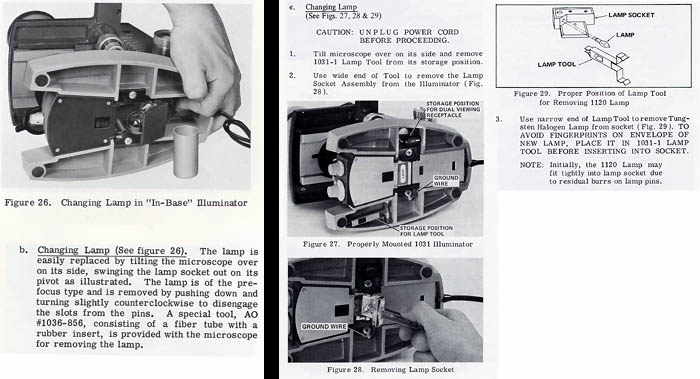
The most common AO condensers are the Abbe N.A. 1.25 and the Aspheric N.A.1.25. The Abbe is a two-element design, while the Aspheric (or Aplanatic) is a three-element design. You could order either one on the Series 10, for instance, and, surprisingly, for the same price. The Aspheric (Aplanatic) design corrected for spherical aberration, but not chromatic aberration.
Quoting from Needham (1958, 'The Practical Use of the Microscope, pp. 271-272):
"The aplanatic condenser is not corrected for color, hence objectionable color fringes are produced around the field of view diaphragm. For this reason, it is intermediate in correction between the Abbe and the achromatic condenser. For the finest visual and photomicrographical work the fully corrected achromatic condenser is preferred."
Why would you order the Abbe when you could have had the Aspheric for the same price? I don't know. I have both types and find the Abbe better for use for DF (darkfield) with a simple stop. Needham notes the Aplanatic as "the best one for microprojection." Perhaps the greater working distance of the Abbe (3.5 mm vs. 1.5 mm for the Aplanatic, at least according to Needham) was attractive for some uses?
But AO Spencer -did- produce very fine Aplanatic-Achromatic condensers (Needham writes: "they are very well corrected so that they are suitable for the finest visual observations and for photomicrography in color") in both a 1.30 N.A. and a 1.40 N.A. design, and these can be picked up, at times, on eBay (usually in conjunction with a Series 2 or 4, or, more likely, one of the earlier 'Black' scopes).
Below: Eldred Spell's AO 1.4 N.A. Aplanatic-Achromatic condenser 'slung' beneath a fine Spencer Series 3 'Black Beauty'. Eldred reports, that with the AO Spencer APO objectives, "I actually believe this is the sharpest scope I own" -- and he owns a lot of fine optics and scopes -- AO and otherwise.
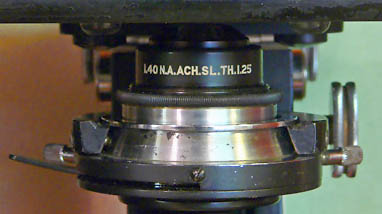
Needham list the specification of the 1.40 N.A. design in the table below with the note: "The following dry and oil immersion achromatic substage condensers are excellent computations capable of fully playing their part in critical image formation with high aperture objectives. The aplanatic aperture of each was determined experimentally by the author."
(Above: Eldred Spell's beautiful C158 90x APO (we think that is what it is anyway)
Oh the many and varied uses of a Q-Tip . . . :-) Eldred demonstrates, to the skeptical :-) , that there are definitely -no- optics in the upper, separable portion of the APO 90x
Eldred provides this picture of his Series 2-Series / Series-4 hybrid set-up on an Ortho illuminator, which I'd say is best titled 'APO Fever' because now he is going to have to find APO Cat#'s C150, C152, C154 (10X , 20x, and 43X) objectives to round out his scope, and he is now a driven being, unable to stop until he finds them. Beware of APO fever! ;-)
Later . . .
. . . it seems the APO fever has run its course ;-)
But, NO. What's a bunch of APO Objectives without a 1.4 N.A. Aplan-Acho Condenser to drive them? :-) These are mounted on Eldred's Spencer Series 3 research scope. It's a strange paradox, but the optics on these older 'Black' scopes can be the sharpest you've ever seen on any scope of any age. They built'em well back them.
As you can see from the graphic at the top of the page, or from the 'Objectives' page, AO (Spencer) -did- produce Apochromatic Objectives for the Series 2 & 4, and for the earlier 'Black' scopes. These are all, of course, 160mm T.L. objectives. With the advent of the Series 10 and infinity correction for all of AO's lines, they discontinued offering APO objectives (i.e. they abandoned the research market - opting instead for the main-line laboratory market) and focused on improving their Achromatic Objectives offerings (which are very fine lenses, by the way - in the plan configuration they offer very wide, flat, bright, excellently corrected views, as good as a fluorite objective in my opinion . . . which doesn't mean much :-) )
But, what may not be so well known is that Reichert, late in the game, offered Apochromatic Objectives in 10x and 40x that fit the earlier AO scopes (i.e. same 34mm parfocal distance):
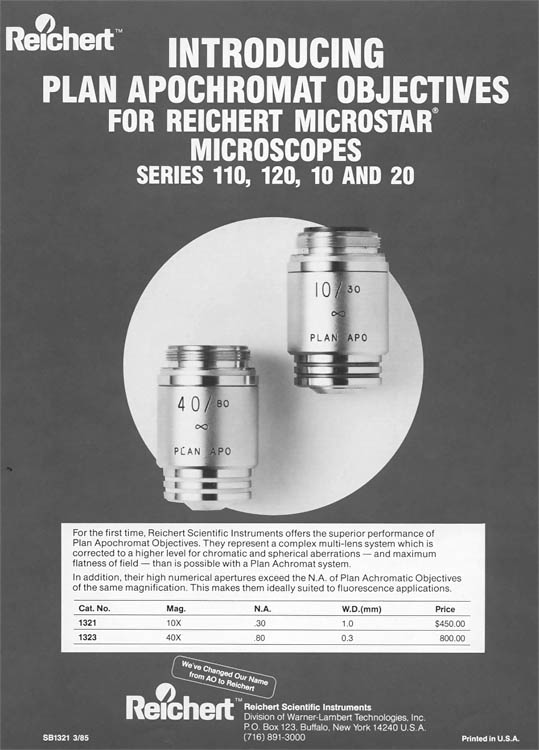
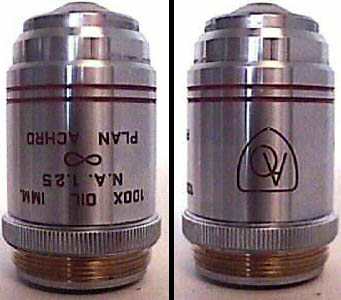
I noticed a strangely configured 100x on eBay (above) with the following description:
"This Infinity Corrected AO American Optical microscope PLAN ACHRO, 100X 1.25 N.A Oil Immersion objective lens, Catalog Number 1024 came from a fully functional microscope system. The optics are free of scratches. These particular AO objectives were made in Austria and are stated to be of better quality than the standard AO objective."
I asked about it on the Yahoo Group, with the following results:
"Hello Steve, I saw this item before you penned your post. Very unusual, indeed. My first thought was this might have been made during the transition, after AO and Reichert was acquired by Warner Lambert ('81 - '82). But then, what I call the "large barrel diameter" newer style objectives had already been released (you call them higher Cat #'s).
So, was this the first production run "100x Austria" after the W-L takeover? Hard to say. Mark at Reichert Buffalo might be able to lend some insight, a few of the original fellows from that many years back are still around.
Cheers, Gregg
>> I've never seen this before. See ebay# 7617439396. It is stated to be a Cat# 1024 AO Objective, made in Austria. It appears to be spring- loaded. I had the impression that the earliest spring-loaded objective that AO made was the 63x, and that -after- they had changed their name to AO-Reichert. Also, I thought they had before that time abandoned the Cat# 1024 in favour of higher Cat#s. The Austria comment is interesting -- did Reichert make objectives under the AO name? But here clearly is a 100x objective, marked simply AO, and with a spring-loaded tip??? Any info on this? Thanks, Steve<<"
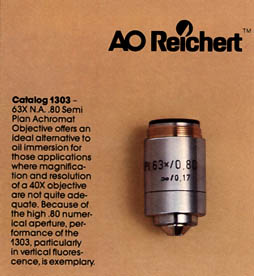
Later, I found a 40x on eBay, and its 'twin' 1024 100x, that looks like the same, strange, spring-loaded design . . .
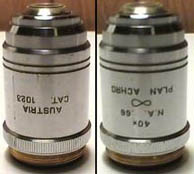
Stan Ayers faced the task of providing compact fluorescent illuminators for 6 AO Series 10's (although a modification of this would work for Series 2's, etc.) for his local school and decided to design and build them using readily available parts -- total cost of less than $15 a piece. Stan has kindly provided the pictures below and plans here as a ppt file (Microsoft PowerPoint).
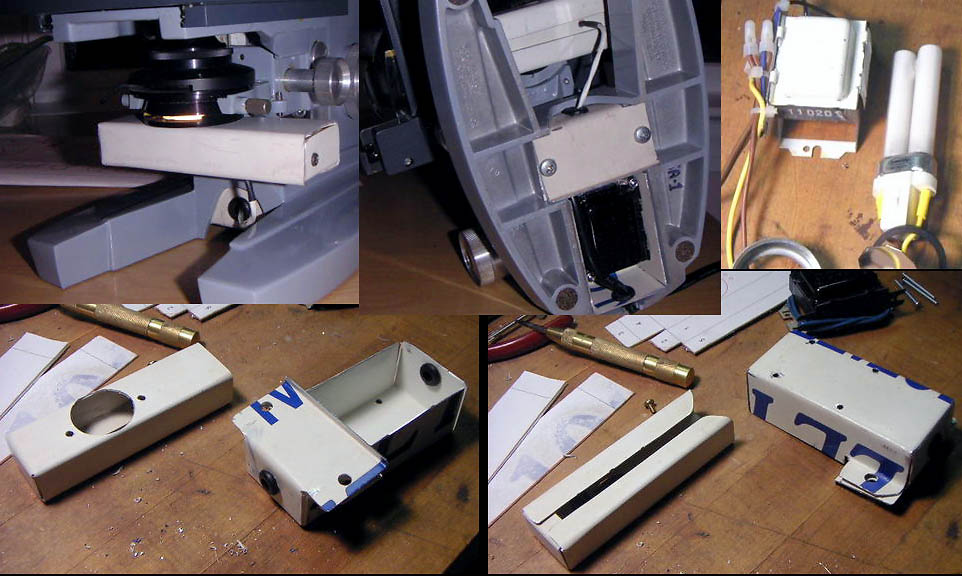
I've included Stan's message to me below since it reveals the important details of the electrical parts for these units.
"I don't have any CAD SW for properly capturing the design. I have been developing patterns on PowerPoint (best I can do for now.) Here they are, attached, with some photos showing how it goes together.
There are two designs, one that I previously reported, and the later one that's fully enclosed. The later one's more likely compliant to fire codes, and a bit less awkward to build- although I have only completed examples of the earlier design.
I think I put up some pics some time ago about how the CF lamp holder assembles with the wire, etc. I haven't changed that. Key to fabbing this part is the big hole for the condenser to bolt up to. Careful if you punch it before bending. I wait until it's bent and cut it with a hole saw- always a tense operation. Note the four screw holes- that is because some AO stages have focus knobs on one side and some on the other. The mount holes on the condenser are offset a bit.
I recommend soldering wires to the lamp. Sockets are too bulky. I used Teflon wire , but it doesn't get that hot as I feared. Seems that regular PVC is fine.
To build it, I print the pattern, stick it down to a heavy cookie sheet with pancake syrup, and just cut it out and bend it on wood blocks. I cut with a band saw, but a jigsaw would work.
The lamp holder cover width needs to be hand trimmed, so that it slides in correctly. You want it to force the sides of the other part open a bit, so it wedges in place. A slight taper usually works. When you are mounting the lamp, you'll need some spacer/ cushions to keep the glass end from banging around. Nothing elaborate. Silicone caulk might work just fine. I make spacers from silicone impregnated fiberglass cloth, and I put a buna N O-ring around the tip end of the glass as a spacer/bumper. Wrap it with string and silicone, etc. The socket end is sprung in place by wedging in with the slide.
Cookie sheets are .035 plain aluminum- that may be just on the thick side. You could probably do fine with steel ductwork sheet, etc. The lamp holder needs a little springiness for the slide-in thing to work. That's all, really. Oh, and it helps to paint the back side of the lamp holder housing bright white. Evens out the field luminosity.
I don't have my previous postings to the group- but I think I already made a parts list. The bulb is 5W CF. Ballast is a LC-49C. Get them at an electrical supplier, or- where else- like on eBay."
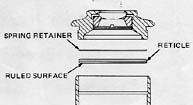
Reichert offered the following :
I also have a couple of older versions (but really, they are very close to the above) that I wanted to offer for the following reasons:
Brings in the Cat# 177: Reference manual for inserting reticles in eyepieces Cat# 146, 147, 157, 176, 177, 184.
Adam Snow writes (on 5/26/2017): "I
recently obtained a Series 56 and wanted to add a reticle, but discovered that
reticles are priced in the $100 range. I figured I could find something for
less.
This
surplus site
(i.e. Surplus Shed) sells a 21mm reticle which fits perfectly for only $2.25.
Item Number: M2320
I mounted the reticle (Adam's eyepiece is a 15X W.F.
Cat #147) as shown in the manuals, but was
never able to focus on the etched scale. Instead I simply dropped the reticle
into the base of the eyepiece. To retain the reticle, I fabricated a few rings,
but later discovered that a simple O-ring retains it. The ring I used is stocked
by Lowes as a Danco #13 O-RING (7/8” O.D. x 11/16” I.D. x3/32”). A 10 pack was
$2.00 in the plumbing section.
I created a calibration chart with a pair of calipers for
each magnification level, I can now easily measure to within a few thousandths
through the eyepiece. I would be great if the reticle had finer subdivision, but
saving $90+ is also nice."
Adam also shares his calibration results for the Surplus Shed reticle:
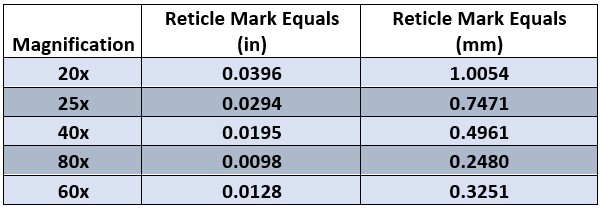
New! 01-21-2018. Tom Woods shares his spreadsheet of eyepieces and reticles here.
Depends. A Series 10/20 head might be usable on a 110 or 120. But the 110/120 head is backward compatible with the Series 10 and Series 20. Eldred Spell notes this in a Yahoo Microscope group post: But below this you will see another post, from smokester, that notes that AO made a change to their design 'later in the game'.
"The Series 10 heads have a protrusion which is not present on the Series 110 heads, so the 10 Series bodies have a deeper recess for the dovetail. This means that the 110 heads are backwardly compatible, but not the other way around. AO made an adapter with a deeper recess which allows putting a 10 head on a 110. I only mention this because I happened to get one. The later Microstar IV head is also backwardly compatible. 'Not for the fashion conscious, but functional. The 181 oculars seem to produce a bright spot in the center of the image. I dimly recall an explanation for this. Perhaps someone else can enlighten us - so to speak."
"Sorry to muddy the water BUT I have both scopes and the
heads ARE cross compatible both ways. I did some research online and it seems
that an "early" (as opposed to later 110 head) was deliberately cast with a
protrusion that prohibited mounting on the 10's. At some point the casting
was changed. Unfortunately, There are no serial numbers on the heads to get a
fix on the crossover date. Worst case scenario---why couldn't you grind
off the protrusion if it were to have one?
I see no difference whatsoever in the ease with which mine are interchangeable."
Eldred Spell has create a website outlining his conversion of a Series 2 (or 4) to use a cheap, available at Wal-Mart, LED. Details here:
http://eldredspellflutes.com/LED_index.htm
Also, see his Yahoo Microscope Forum message here:
http://tech.groups.yahoo.com/group/Microscope/message/33475
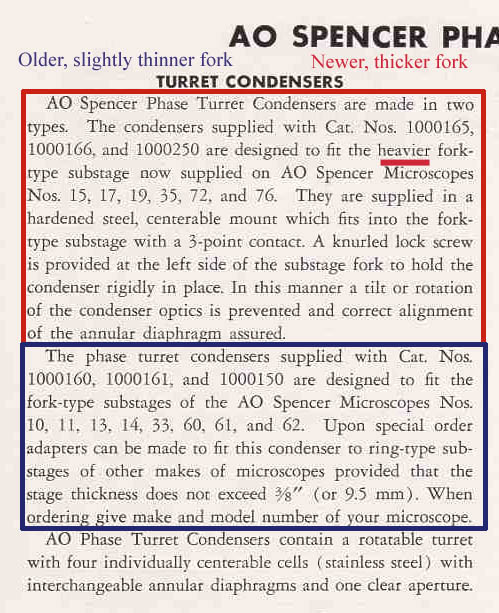
Above is a portion of page 11 of the AO Cat# 15 and 35 Phase Catalog. As you can see, AO changed the design of the fork mount to use a slightly thicker mount when the Series 15 came out. Earlier forks were thinner. What does this mean? Condensers made for the earlier fork will not slip into the later fork (this is unfortunate, because sometimes N.A. 1.4 Achro condensers made for this older era scope come up on eBay and it is very tempting to try to use them on your newer Series 10 or 20 scope - won't work unless you grind down an extra fork you've got laying around).
Note: The No. 10 referred to in the above is not the Series 10. These have the newer, thicker fork.
Thanks to Matt Brin for pointing all this out. I had actually made an error in an article where I said that all AO forks and condensers were of compatible design - they are not. See below for portions of the email from Matt below:
"Steve,
No apologies needed at all. I was just wondering what you knew.
The series 15/35, series 2/4 and series 10/20/110/120 all seem to use the same fork. I think the "med" scopes 13/33 might have had the older fork without the centering tab. The problem is that there are some bodies in the 15/35 series that look identical to the 13/33 series. The 15 and 35 themselves have the sleek lines, but others in the same catalog have bodies that seem identical to the older "med" scopes.
I finally figured out that the reason that the older condensers do not fit is that the tines of the newer fork are too fat for the older condenser slots. For a long time I though the dovetail on the older condensers was too wide or had the wrong slope. This in spite of the fact that they are obviously smaller.
In any case, I do not own a 13 or 33 scope. So much of this is guesswork.
As far as I can tell 300000 approximately starts the series 15/35, 400000 approximately starts the series 2/4 and 500000 approximately starts the series 10, etc.
All this might be a lot more detail than you want. It is all motivated by a (probably hopeless) hunt for one of the AO aplanatic, achromatic condensers. I have only seen one show up in a couple of years.
Matt
On Sunday 06 May 2007, you wrote: > Matt, > > I know what you mean. I've encountered the same problem. I guess the > fork was changed somewhat through the years and my statement is in > error. I don't know when the change came nor do I know how to > identify those that are compatible and not. > > Sorry, > > Steve"
A further thread on Yahoo focuses on the 1084 and 1087 condenser differences. Ted Coffey gives a very complete answer and furnishes this image:
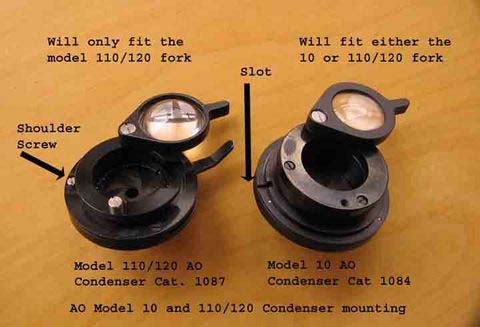
Thanks to Don Williams (See Yahoo! microscope thread 37959) for pointing out that a Haemacytometer can be used as a stage micrometer. His message reads:
"Unless the cover glass is in the box you won't be able to use it as a counting chamber. But it will be very useful as a stage micrometer for calibrating an eyepiece graticule. Stage micrometers are usually rather expensive -- so you've got one very cheaply. But the line spacing depends on the ruling. It it's very old it might not be 'Improved Neubauer' (IN) and without the handbook you'll need to do a web search. I can send you details of the IN ruling if you need them."
These seem to appear on eBay all the time at fairly low prices, while stage micrometers seem to go much higher. But, since these Haemacytometers were very, very precisely ruled, they -can- make an excellent stage micrometer. All you need to know to use the AO Spencer Haemacytometer (Bright-Line) as a stage micrometer is below as found in the manual (note: you can get the manual for the AO Spencer Bright-Line Haemacytometer here (4.6 MB zip file)).
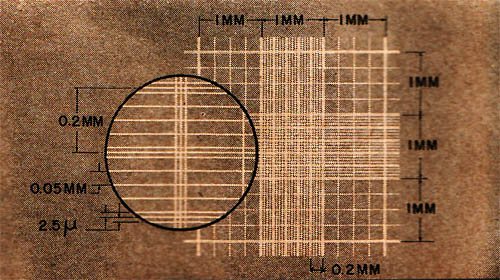
As Don points out, if you want to use them as a counting chamber, you'll need the special coverslip. As you see,
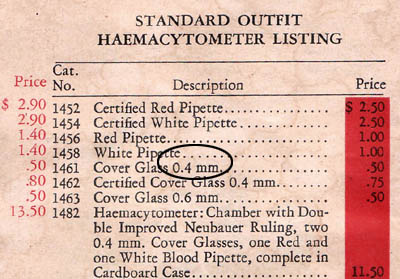
the special coverslips (two came with the cytometer) were 0.4mm thick (for comparison, a #1 regular coverslip is 0.15mm in thickness, and a #1 1/2 is 0.17mm thick).
Note: If you need some of these, Cynmar has them at a very reasonable price.
The manual (downloadable just above) has instructions for using the chamber, but is a link that may also be helpful:
http://www.ruf.rice.edu/~bioslabs/methods/microscopy/cellcounting.html
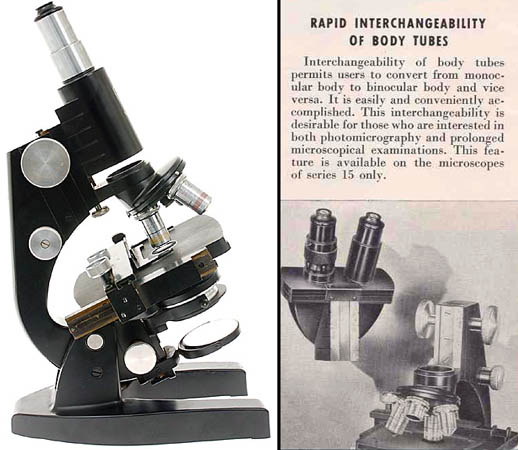
No, that scope is not broken! :-) But it is not going to work very well that way - the owner needs to tighten that screw so that body and nosepiece can work together. Why this feature? Answer: The Series 15 sported an interchangeable body -- a feature that differentiated it from the Series 35.
AO phase condenser, as every turret phase condenser, need two centering wrenches to center the annuli. AO made 'captured' and 'removable' configurations. The 'captured' is nice because you don't normally lose the wrenches that way. But with 'removable' (they were removable, supposedly to prevent inadvertent -- for instance, a student - messing up the alignment) they are very easy to lose. But Matt Brin offers this advice:
"The set screws (this is for loosing the 'cans' on an old AO Stereo Microscope) are turned by 0.050 inch allen wrenches. This size is used a lot by people who adjust pickups on electric guitars. A good cheap source is http://www.universaljems.com/cart/tools.htm The desired tool is: AW 0230-000 Current price is $2.70 each plus shipping. I recommend at least two and maybe even three to make it easier to fiddle with more than one set screw at a time. These are long and have handles. It might be more convenient to have traditional style allen wrenches if you are going to have them sticking out of the sides of the objectives as you work, so item AW 4210-003 which gives 25 traditional L-shaped wrenches for $9.00 plus shipping might be in order. Note that 0.050" is also the size of the wrenches on the AO phase turrets. A pair of the AW 0230-000 are great if you have a phase turret where the original wrenches have been lost. "
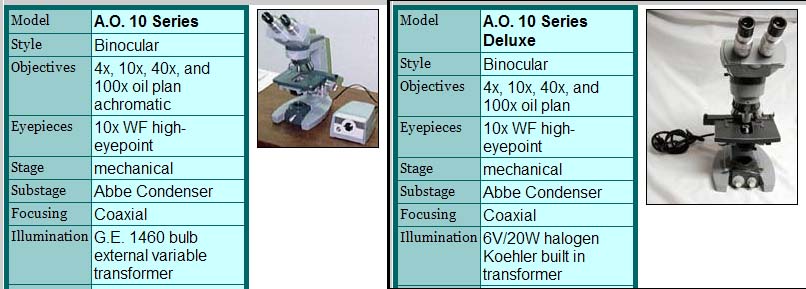
It's a trick question. There is no such thing as a 'Deluxe', although at least one reseller of used microscopes (ad above) used this term, thus confusing some. Wayne Buttermore gives a definitive answer:
"The Series 10 described as a Deluxe, by the
way, there never was a Series 10 Deluxe as Gregg correctly commented, is catalog
number H10 BU-FW; the other system was called a L10BU-FW. If the objectives were
achromats, the extension would have been QW with a 4 objective package. I can
tell you that early version of the Halogen systems experiences socket failures
due to heat. AO swapped out sockets at no charge for a year or so after problem
was discovered, the updated sockets had a red ink imprint on the bottom of the
socket and a clearly silvered service along the contact strips. The scope
pictured probably was updated, but the sockets are no longer available. Both
scopes pictured seemed to be very complete and look clean . . ."
No. Not AO. BUT, noted microscope expert Dave Jackson shares the following about the LOMO 70x and 85x water immersion lenses that often appear on eBay:
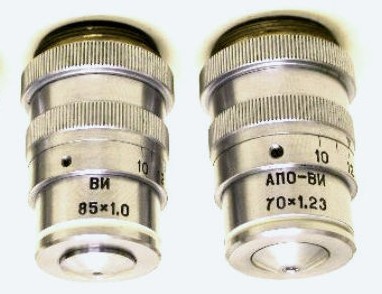 "One
little 'secret" to these is that the 70x and 80x should work very well on an AO
10 or 110 for "dipping" -- direct immersion without a coverglass.
"One
little 'secret" to these is that the 70x and 80x should work very well on an AO
10 or 110 for "dipping" -- direct immersion without a coverglass.
The corr. rings are set to .010 -.012, depending on the objective and the shift
from 160mm to infinity focus takes care of the rest. As the 40x is already a 'no
cover' type, this trick won't work on that (or the 30x).
The 70x is notorious for lack of working distance but this trick solves that
problem, roughly more than doubling it."
Tom Woods writes (on 01-05-2021): "You state that AO
(Spencer) did not produce W.I. objectives, but I know of at least one case, and
I have a physical example of it in my collection (see photos of my lens,
attached). I have only been able to find this objective in one Spencer catalog,
the one dated 1929. The 60X W.I. lens is described in the 1929 catalog on page
42 ("Telegraph Code 124, focal length 3 mm, 60X, N.A. 1.0. Cost was $30 ($450 in
today's dollars!)). The only difference is that the lens in my possession is
N.A. 1.15, while the one in the catalog is described as N.A. 1.0. The N.A. 1.0
catalog description may be a misprint, for I only know of this lens existing in
a N.A. 1.15 version.
This is the only case I know of where AO/Spencer produced a Water Immersion
objective." Here is Tom's objective:
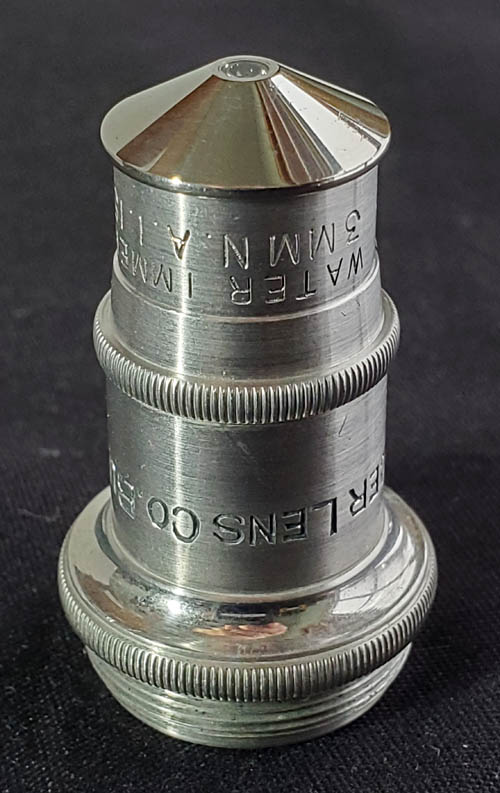 An update from Tom on 6/24/23: "At the time I
contacted you about my W.I. objective (Jan 5 2021) I did not have access to the
Spencer catalogs, dated 1896 and 1914, made available to everyone quite recently
through the generosity of Wallace Kelley. In the 1929 catalog, the 60X Spencer
water immersion objective is clearly listed as having an N.A. value of 1.0. I
thought this might be a misprint because my lens (pictured above) has an N.A. of
1.15. However, the 1914 Spencer catalog does show a N.A. 1.15 3mm water
immersion objective, so my lens must be from that era.
An update from Tom on 6/24/23: "At the time I
contacted you about my W.I. objective (Jan 5 2021) I did not have access to the
Spencer catalogs, dated 1896 and 1914, made available to everyone quite recently
through the generosity of Wallace Kelley. In the 1929 catalog, the 60X Spencer
water immersion objective is clearly listed as having an N.A. value of 1.0. I
thought this might be a misprint because my lens (pictured above) has an N.A. of
1.15. However, the 1914 Spencer catalog does show a N.A. 1.15 3mm water
immersion objective, so my lens must be from that era.
It is a mistake to imply that AO/Spencer
did not make water immersion objectives, because clearly they did. And even more
to the point, the 1896 Spencer catalog, on page 18, lists three different water
immersion lenses. Interestingly, the 1/15 inch Spencer W.I. objective (about
110X), N.A. 1.30, sold for $100 in 1896. That is the equivalent of over $3,600
in today's dollars!"
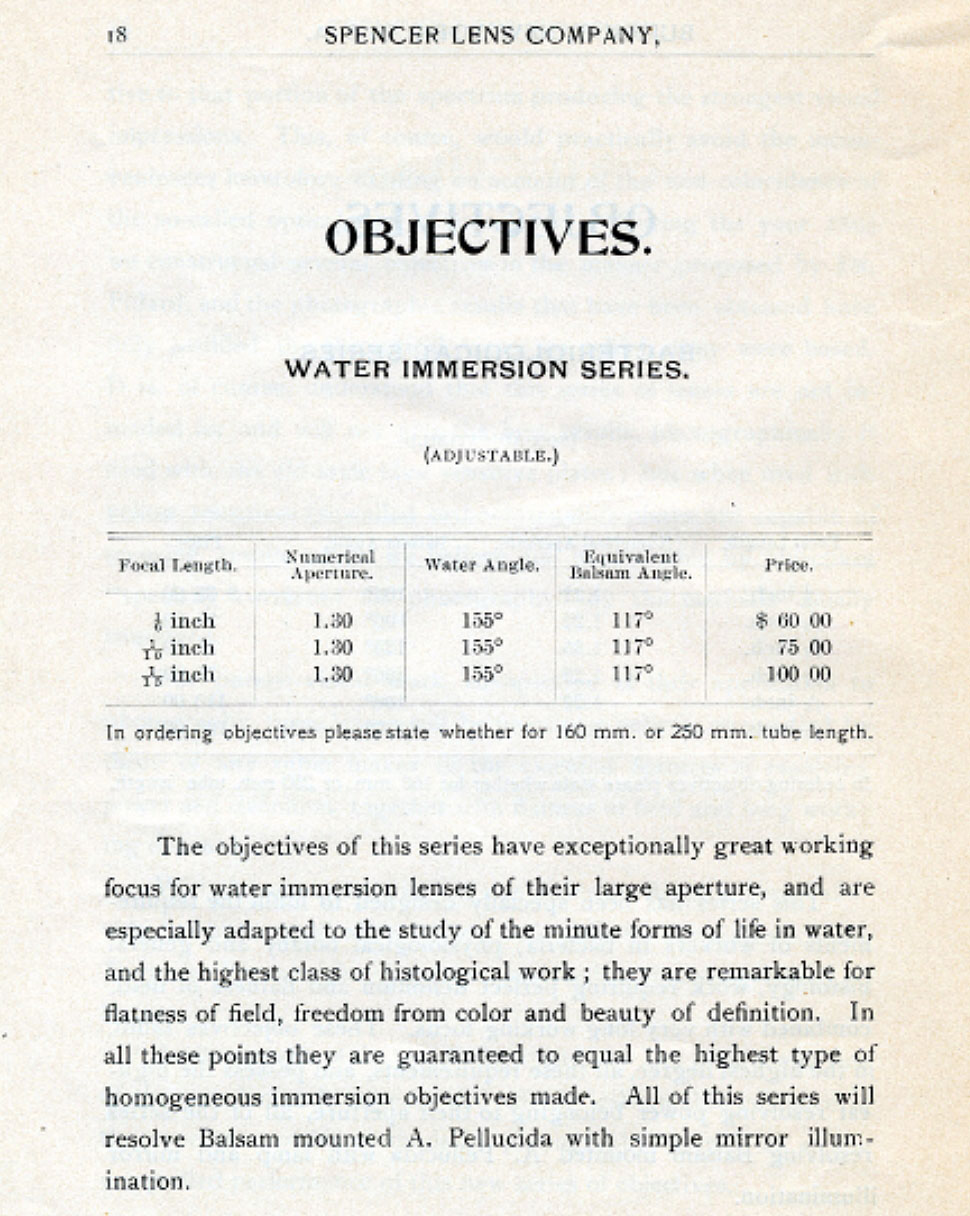
Tom also shares one experienced friend's (i.e. Barry Danard) comments on using the Lomo 40x water immersion on an AO infinity scope:
"Works wonderfully well on my AO 110 scope. Not parfocal, but spacers can remedy that quite easily. Yes, I have always used the 40x with cover slip and obtain quite good (excellent, actually) images. Very handy in case I need that little bit of extra resolution without having to clean up after using the 50x oil, and it is only a moment's task to blot the coverslip preparation and co)intinue to examine the slide (we're talking here of wet mounts of freshwater biota)."
Update from Tom on 11-12-25: "This is another example of a Spencer water immersion objective. This particular objective is 95X with a 1.8mm focal length. The N.A. is 1.20. I searched several of my catalogs (1914, 1924, 1929, 1935) and cannot find this objective described in any of them. The lens serial number is 194216, and the objective is in pristine condition."

|
|||||||
|
|||||||
|
|||||||
|
|||||||
|
|||||||
|
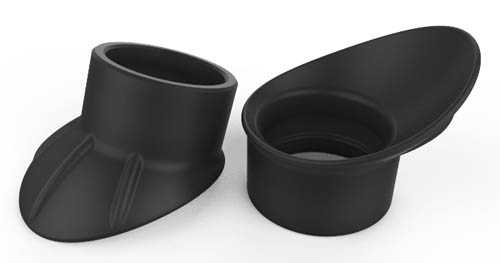
Adam Snow shares files for 3D printing and/or machining of eyepiece eyecups for the Series 56 Cycloptic: "I’ve attached the CAD data for the eyecup in two formats, STL and Step. The ID of the hole may need some sanding/scraping to fit, but it depends on the machine building it. 3D printers will want the STL. The Step file is a common format which most CAD systems can import."
William Noble writes: "The attached messages
document my conversion of an AO series 10 to LED, it was pretty easy. If
you choose to use it, please just credit me. I might some day write it up
as an article on my own web site (www.wbnoble.com)
but not tonight.
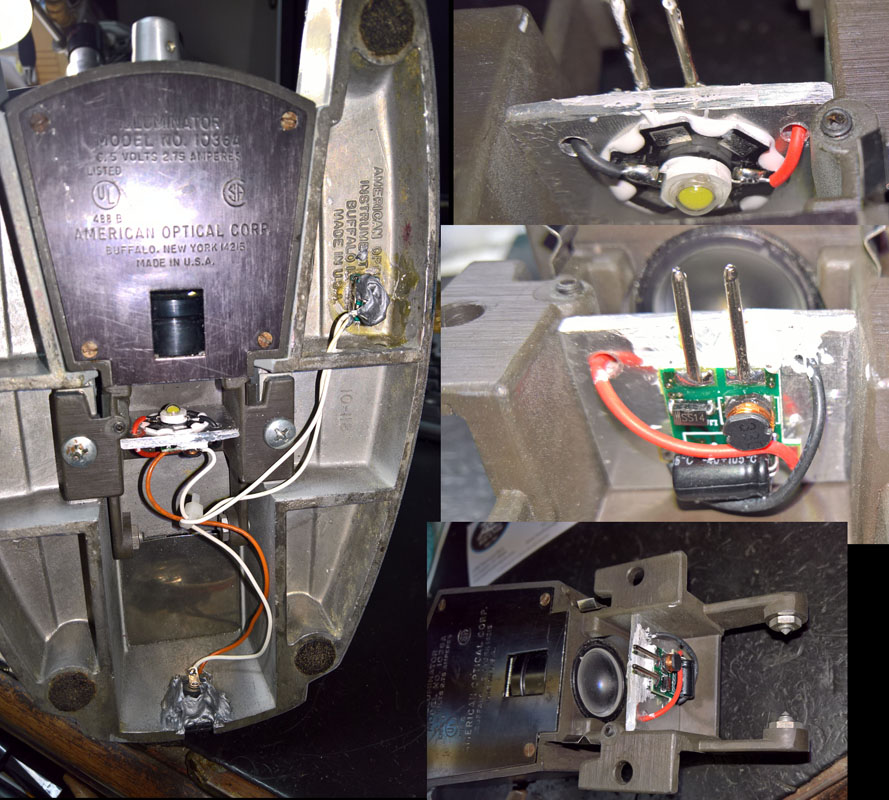
Leaving the Delta system aside for now, it turns out that each of those 3 AO
designed objective families can be used in any AO or Reichert-manufactured
infinity microscope spanning 40 years of production simply by making an
alternate eyepiece choice for either the 23.2mm tube or 30mm tube. This means
for instance that you could use (if you can find one) a Reichert 100X 1.32 Plan
Apo objective in a 60-year-old AO series 10 (sliding the stage lower on the
locking dovetail some) and achieve full edge-to-edge correction or conversely
use the fairly common AO cat. # 1014 100X w/. iris oil immersion planachro on a
Polyvar along with an 11 mm collar for DF. Such objectives were sometimes sent
out of the factory with the collar. I know this because I have one. A cat.# 1309
63X .80 Spl. with a factory-mounted 11 mm. extension. Neither of the above
objective/stand combinations, by the way, require any eyepiece replacement at
all ; both use the standard factory-supplied eyepieces.
Now, not all AO/Reichert 34mm objectives can achieve the 24mm f.o.v. required by
the Polyvar but in reviewing quite a few patents, most of the desirable ones
can, so hopefully this expands the possibilities for all users of AO and
Reichert infinity microscopes.
Presumably, a similar relationship holds for the epi and metallurgical
objectives too, but the thread difference, and the fact that many more examples
of Reichert incident objectives exist, means that moving objective families
across stands is a less attractive option for those systems."